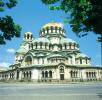 |
St. Alexander Nevski Cathedral – Sofia |
 |
 On August 30 1724, Peter I officially moved the relics of St.
Alexander Nevski to Russia’s new capital – Petersburg. On this
day in 1924, the St. Alexander Nevski cathedral in Sofia was
inaugurated. It is one of the town’s biggest historical monuments,
as well as one of its most distinctive symbols. It is also the biggest
memorial-church on the Balkan peninsula. It was built in memory
of the Russian king Alexander I, whose troops liberated Bulgaria
from the Turkish yoke in 1878. The cathedral occupies an area of
2600 sq.m., it is 70 m in length and 55 m in width. It represents an
impressive five-nave basilica of cruciform domed type. The church
itself is round in shape, consisting of three altar apses: central,
dedicated to St. Alexander Nevski, southern – to King Boris I the
Baptist, and northern – to the wholly brothers
Cyrill&Methodius. The icons and frescoes in the cathedral are
the work of distinguished Bulgarian and Russian artists. Most of
them are extremely precious and unique exponents, one of which
is the Pearl icon of The Holy Virgin and her child, which people
believe has miraculous powers. Another precious exponent is the
Golgotha stone, which is placed in a box, made of mother-of-pearl
bearing the Bulgarian kingdom coat of arms. It was given to the
church as a gift by patriarch Cyrill.
On August 30 1724, Peter I officially moved the relics of St.
Alexander Nevski to Russia’s new capital – Petersburg. On this
day in 1924, the St. Alexander Nevski cathedral in Sofia was
inaugurated. It is one of the town’s biggest historical monuments,
as well as one of its most distinctive symbols. It is also the biggest
memorial-church on the Balkan peninsula. It was built in memory
of the Russian king Alexander I, whose troops liberated Bulgaria
from the Turkish yoke in 1878. The cathedral occupies an area of
2600 sq.m., it is 70 m in length and 55 m in width. It represents an
impressive five-nave basilica of cruciform domed type. The church
itself is round in shape, consisting of three altar apses: central,
dedicated to St. Alexander Nevski, southern – to King Boris I the
Baptist, and northern – to the wholly brothers
Cyrill&Methodius. The icons and frescoes in the cathedral are
the work of distinguished Bulgarian and Russian artists. Most of
them are extremely precious and unique exponents, one of which
is the Pearl icon of The Holy Virgin and her child, which people
believe has miraculous powers. Another precious exponent is the
Golgotha stone, which is placed in a box, made of mother-of-pearl
bearing the Bulgarian kingdom coat of arms. It was given to the
church as a gift by patriarch Cyrill.
|

 Last Issue
Last Issue

 Subscribe NOW!
Subscribe NOW!
 Български
Български

 On August 30 1724, Peter I officially moved the relics of St.
Alexander Nevski to Russia’s new capital – Petersburg. On this
day in 1924, the St. Alexander Nevski cathedral in Sofia was
inaugurated. It is one of the town’s biggest historical monuments,
as well as one of its most distinctive symbols. It is also the biggest
memorial-church on the Balkan peninsula. It was built in memory
of the Russian king Alexander I, whose troops liberated Bulgaria
from the Turkish yoke in 1878. The cathedral occupies an area of
2600 sq.m., it is 70 m in length and 55 m in width. It represents an
impressive five-nave basilica of cruciform domed type. The church
itself is round in shape, consisting of three altar apses: central,
dedicated to St. Alexander Nevski, southern – to King Boris I the
Baptist, and northern – to the wholly brothers
Cyrill&Methodius. The icons and frescoes in the cathedral are
the work of distinguished Bulgarian and Russian artists. Most of
them are extremely precious and unique exponents, one of which
is the Pearl icon of The Holy Virgin and her child, which people
believe has miraculous powers. Another precious exponent is the
Golgotha stone, which is placed in a box, made of mother-of-pearl
bearing the Bulgarian kingdom coat of arms. It was given to the
church as a gift by patriarch Cyrill.
On August 30 1724, Peter I officially moved the relics of St.
Alexander Nevski to Russia’s new capital – Petersburg. On this
day in 1924, the St. Alexander Nevski cathedral in Sofia was
inaugurated. It is one of the town’s biggest historical monuments,
as well as one of its most distinctive symbols. It is also the biggest
memorial-church on the Balkan peninsula. It was built in memory
of the Russian king Alexander I, whose troops liberated Bulgaria
from the Turkish yoke in 1878. The cathedral occupies an area of
2600 sq.m., it is 70 m in length and 55 m in width. It represents an
impressive five-nave basilica of cruciform domed type. The church
itself is round in shape, consisting of three altar apses: central,
dedicated to St. Alexander Nevski, southern – to King Boris I the
Baptist, and northern – to the wholly brothers
Cyrill&Methodius. The icons and frescoes in the cathedral are
the work of distinguished Bulgarian and Russian artists. Most of
them are extremely precious and unique exponents, one of which
is the Pearl icon of The Holy Virgin and her child, which people
believe has miraculous powers. Another precious exponent is the
Golgotha stone, which is placed in a box, made of mother-of-pearl
bearing the Bulgarian kingdom coat of arms. It was given to the
church as a gift by patriarch Cyrill.